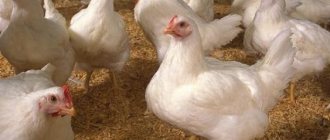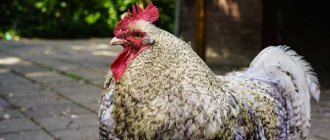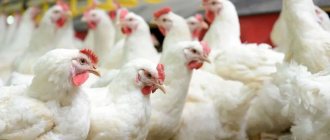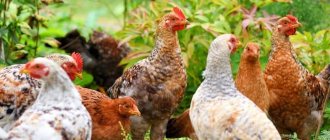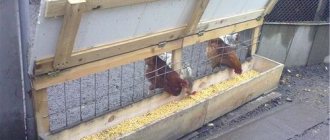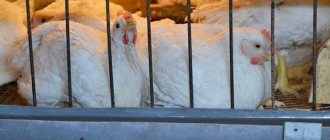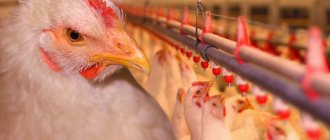Some breeds of poultry were bred by crossing different species to improve existing beneficial properties and create new ones that facilitate poultry breeding in industrial conditions and in households. You can find out the weight standards of a Cobb 500, Ross 308 or 708 broiler by day at home in the table below. This is necessary to understand how the bird develops and how suitable certain conditions are for growing.
Broiler growth chart by day
Daily weight gain plays an important role in the further development and growth of birds. Under normal conditions, a broiler should gain more than 65 grams per day (provided that the value varies depending on the sex and age of the bird).
Using this table of broiler growth by day, it will be easier to track its normal development (table):
10 days
The first weighing of chickens is recommended when they reach ten days of age. It is from this period of life that one can judge the further development of the chicken.
A healthy chicken at this age weighs on average 200 grams. Starting from this point, the weight of the broiler will begin to increase rapidly. Weigh yourself at least once a week, this will allow you to timely detect the cause of weight loss, if any.
1 month
How much should a broiler weigh at 1 month? It depends on many factors.
At one month of age, a healthy bird reaches 1.6 kg of live weight. If the weight is significantly below this mark, reconsider your options for keeping pets. It is possible that you made a mistake in the initial stage of cultivation. Correcting the feed and living conditions can improve the situation and allow the broiler to gain the required weight.
2 months
With proper care and nutrition, the weight of a broiler at 2 months is about 2.7 kg. Inadequate nutrition or poor living conditions can significantly reduce this figure.
At this age, chickens should be given as much greens as possible. To make birds grow faster, feed them grain mixed with crushed potatoes - this will avoid vitamin deficiency and enrich the body with important minerals and vitamins.
To ensure that broilers do not have a protein deficiency, feed them milk and curdled milk, but under no circumstances replace water with them.
Characteristics of the Cobb 500 breed
When describing Cobb 500 broilers, it should be noted that they are considered one of the most productive crosses. Cobb 500 chickens were bred specifically to produce the maximum amount of meat with a minimum growing time. By the age of 40 days, with proper care, you can get a bird weighing about 2.5 kg.
History of appearance
At the core of their origin, cobb 500 crosses are hybrids, since other varieties were taken as the basis for this breed: Plymouthrock, Kuchinsky Jubilee, Cornish breed, New Hampshire, Zagorskaya salmon, Pantsirevsky, Rhode Island.
Important! Due to the fact that the bird reaches readiness for slaughter in a little more than a month, it is possible to raise several generations at once in one warm season. This is very convenient for those who do not leave their birds for the winter.
The characteristics of the Kop 500 broiler breed make it the best of the meat breeds; this breed is grown all over the world: the USA, Russia, Hungary, Belarus, Ukraine and other countries in Europe and Asia. Still, the Czech Republic is considered the homeland, so Cobb 500 broilers are often called Czech crosses.
Appearance
It is easy to recognize a Cobb 500 bird by its appearance:
- always a white feather;
- powerful physique;
- wide back and chest;
- strong developed paws and legs with large amounts of muscle;
- a small crest of bright red color is characteristic of both females and males.
If a bird gets too angry, it can cause serious injuries. But, despite their power and strength, the breed is distinguished by a calm disposition; they are rarely the first to provoke fights.
On a note. Very often, Cobba 500 broiler chicks themselves suffer from relatives of a more aggressive nature, therefore, having introduced these birds into the house, you should make sure that they do not suffer while they are settling in.
The great advantage of this breed is its good presentation. The meat is white and the skin is yellow, which is not typical for other types of broilers. For example, Ross 308 and 700 or Hubbard breeds have a pronounced bluish tint.
Broiler weight table by week
This table provides detailed information on how much a broiler weighs at 1 month and at an older age:
| Age | Chickens | Roosters |
| 7 days | 90 | 100 |
| 14 days | 170 | 210 |
| 20 - 21 days | 330 | 410 |
| 28 days | 560 | 660 |
| 35 days | 820 | 940 |
| 42 days | 1060 | 1260 |
| 49 days | 1200 | 1500 |
| 56 days | 1570 | 1880 |
Birth weight
Related publications
Pets: proper dog care
Aug 22, 2020
Methods for transporting pets
Aug 5, 2020
The average weight of a newborn broiler chicken is 50 grams. Use this figure as a starting point if you are unable to weigh accurately. Please note that if a chicken exceeds its fellows in weight, then in the future it will be much larger than them. The same applies to lack of weight - if a bird after birth weighs much less than the average norm, then the weight of a broiler at 1 month will be less than that of the rest.
Norms of weight gain for bottle-fed girls and boys
At the moment, parents can rely on several tables that indicate the weight gain of the newborn by month, depending on the type of feeding.
More recently, pediatricians relied only on one table, developed by WHO more than 25 years ago. These values were calculated based on statistics from infants who were predominantly formula-fed. But such children, as a rule, gain weight faster than their peers who feed on mother’s milk.
Below is a table of weight gain for a bottle-fed newborn.
How to determine the weight of a chicken
One of the most important steps for a breeder is regularly determining the weight of chickens. Weighing birds more than once a week will help to accurately determine weight gain and, if necessary, adjust feed.
When distributing feed, it is important to take into account how much food the birds received over the last 3-4 days in order to correctly calculate the scheme for the coming week.
Some tips for accurate weighing at home:
- Weigh the chicks after placing them in the box. This will allow you to determine the average weight of one chicken.
- It is recommended to weigh chickens at least once a week.
- Try to determine the weight of the chicks before you feed them.
- Each bird that comes into the box must be weighed. Don't forget sick or malnourished birds.
- Use a high quality bathroom scale or canter.
- Remember to count the chicks before each weighing.
- Do not change the weighing method under any circumstances to make the data more accurate.
Basic rules of fattening
The acceleration of the growth of broilers is determined by the normal conditions of their keeping, as well as by a complete, balanced diet. Nutrition is provided first according to a frequent schedule, and then, as the chickens grow, the number of their feedings decreases, so it is important to know the approximate age of the livestock. A farmer does not always raise poultry from birth, but you can determine the age of broilers by external signs:
- one week - by this age the chicken’s wings have grown to the tail, but they still remain covered with down;
- 12 days – the chickens’ shoulders are covered with feathers;
- by 19-21 days of life, the crop, back and breast are covered with feathers. feathers on the tail begin to grow;
- at 4-5 weeks the first molt occurs, after which flight feathers appear on the wings;
- within 6 weeks the head and lower part of the body feather;
- By 3 months, the broiler has full plumage, which is ready to shed in the fall.
Considering the age of the broilers, you can adhere to the following feeding scheme, while not forgetting to weigh the birds.
The first 5 days after birth. This age requires maximum attention and care for weak chickens. Such babies should be fed at least 8 times a day (including at night) after an equal amount of time. Their diet should consist of 25% protein, which comes from boiled yolk, cottage cheese and corn grits. Food should be well ground.
The drug “Trivit” is a health and growth stimulator for chickens; it is better to give it in a course - 1 drop 4 times every 7 days. Weak chicks are temporarily kept separately from the rest of the population until they get stronger.
- 6-10 days. Gradually introduce roughage, cereals, and greens. The frequency of meals is 7-8 times, including one night feeding. You can give grated fresh carrots, at first no more than 5 grams per head, then increasing this amount to 20-25 if the chickens’ reaction was normal.
- Closer to 10 days of age, it is useful to introduce lime, shell rock, and small eggshells.
- 11-20 days. Nutrition is already reduced to 6 meals per day. It is good to mix bone meal into the diet and give boiled fish waste. Curdled milk or skimmed milk will improve the microflora of young animals.
21-30 days. The most important milestone when raising broilers, the weight of which must comply with the standards. The cereals are mixed with boiled crushed potatoes, and the broilers peck at the whole grain. Meals – 5-6 times a day. After 30 days, the bird can be completely transferred to an adult diet with 4 feedings a day before slaughter
It is important to add vitamin premixes to food, taking into account the dosage, and carefully monitor the health of the livestock
Throughout the entire growing period, weight gain must be monitored, if not daily, then at least weekly. This procedure makes it clear whether the bird is sick or whether mistakes are being made in the nutrition and maintenance of broilers.
You can learn how to raise broilers from the video.
Broiler is a meat breed of poultry in farmers' households. The most popular hybrids are:
The broiler reaches its maximum weight after 3 months. For this reason, the breeder weighs the chickens daily, controls their weight and calorie content of the feed. This way you can correct shortcomings in growth and get closer to the norm. A broiler growth chart will help you control weight gain.
Organizing poultry nutrition
Nutrition composition
During the first weeks of broiler life, the feed should contain at least 20% protein. After four weeks, replace it with a 19 percent protein feed. Most chicken feeds contain medications to prevent infections, so follow the care instructions before slaughtering birds and dressing the carcass to ensure there are no drugs in the meat.
Feeder
For convenience, it is recommended to use a special chicken feeder. At first, you can use half an eggshell. Over time, you will need to purchase a feeder from a specialty store.
Water
Provide broilers with constant access to fresh water. Use a drinking bowl for these purposes. Remember - the more chickens, the larger the drinking bowl should be and the more often it needs to be updated.
Method of raising chicks
Chicks are obtained in several ways:
- purchasing eggs for hatching chickens in an incubator;
- purchase of one-day-old chicks;
- purchase of chicks 2 - 7 days old.
It is recommended to buy young animals from breeders who themselves breed and sell birds. It is best to contact a poultry farm that also supplies meat products to the market. Then the likelihood of deception will be minimized.
Purchasing young animals from poultry farms is considered the most reliable option
It is worth checking all documents for birds:
- breed certificate;
- vaccination certificate.
To reduce the risk of purchasing sick chicks, you can perform a random check of their health status if a large batch is purchased. But when purchasing a small quantity, each individual can be examined. Experts say that chickens lead an active lifestyle and perceive everything new with interest, so those that sit with their eyes closed in the corner are most likely sick. There is no need to buy them.
Buying eggs for broiler breeding
If you want to constantly breed meat chickens, it makes sense to purchase an incubator. Purchasing eggs will significantly reduce the cost of increasing the number of livestock, since chicks are several times more expensive.
Egg incubators can be purchased or made independently.
You should only buy eggs from trusted suppliers to avoid:
- the appearance of chicks of a different breed;
- purchase of defective or expired eggs.
However, it is necessary to prepare for the fact that the mortality rate of chickens will be quite high. At large volumes, incubation is considered the least expensive way to increase the number of broiler chickens.
Prices for egg incubators
Egg incubators
Purchasing day-old chicks
This is the most common way to start a business. It is especially relevant if a small number of chicks is required. The cost of hatched chicks is several times higher than the price of eggs. But there is no need to purchase expensive equipment and create ideal conditions for birds in the first hours of their life.
It is recommended that only experienced poultry farmers purchase one-day-old chicks due to the fragile health of newborns.
Buying grown up chickens
Here the farmer’s risks are practically absent, but the cost of chickens is maximum. It is necessary to take this step if you are planning a small farm with meat production for yourself and a small circle of people. The price includes all expenses that were incurred by the seller until the sale of the chicks:
- nutrition;
- lighting and heating;
- vitamins;
- labor costs.
The older the chickens purchased, the higher their cost
Thus, everyone can decide for themselves how best to start a business, based on the availability of initial capital and plans to capture the market.
Causes of failure to gain weight
- Low temperature. The room in which the chicks are located must be kept warm 24 hours a day. In the first two weeks, the chickens’ immunity is actively developing, so the temperature should be at least 30 degrees Celsius above zero. After 14 days, the temperature can be reduced to 25 degrees. Please note that Cobb-500 broilers may die in the first week of life if the temperature is significantly lowered.
- Lack of light. In the first days of life, the light should be on most of the time.
- Lack of calcium in the body of chickens. Poor growth can often be associated with poor nutrition.
- Incorrect meal schedule. Often broilers do not gain weight due to insufficient nutrition. In this regard, the body functions only on internal reserves, the metabolism gradually slows down. It often happens that only a few chickens need additional nutrition.
- Parasites. Helminths can affect the functioning of the digestive tract of chickens and inhibit the development of a growing organism.
Microclimate in the chicken coop
A newborn chick has the same body temperature as an adult chicken, but it does not yet have the ability to thermoregulate
The chick's immunity is also reduced, so it is important to provide broilers with adequate care. The organization of the microclimate for young animals depends on the conditions in which the livestock is kept. Chickens can be equipped with a floor area, placed in cages or in a brooder
Humidity and temperature will vary slightly. Young animals begin to be walked only on the 7th day, if the air temperature is normal
Chickens can be provided with a floor area, placed in cages or in a brooder. Humidity and temperature will vary slightly. Young animals begin to be walked only on the 7th day, if the air temperature is normal.
If you plan to keep chickens on the floor, then you need to equip them with bedding. Sawdust is used as flooring. They are laid on a layer of slaked lime. The regimen will depend on the age of the chick.
It is recommended to adhere to the following temperatures (C):
- for a newborn chick up to 5 days – 23-24: under the lamp – 34-35:
- before 10 pm – 22-23; under the lamp – up to 30;
- until 20 pm – the room temperature does not change; under the lamp – up to 27;
- up to 30 – indoors – up to 22; under lamp 24;
- up to 40 – up to 18; under lamp 20;
- up to 60 – maintain the regime.
The humidity in the room for newborn chicks is slightly low - 40%. Subsequently, the air is humidified to 60-65%. This is achieved by ventilation. The bedding of young animals should always be dry. It is changed during a technical break when changing livestock. When kept outdoors, there should be no more than 7 heads per 1 m2. Every week the chickens are moved to different rooms or the housing area is increased.
Keeping young animals in cages is considered more productive. It is easier to care for individuals: you can control how much food the chick consumes. Young animals get sick less often.
It is necessary to maintain the following temperature indicators for broiler chickens (C):
- newborn chickens 1 day in a cage – 32; in the room - 26;
- until 5 days - in cage 29; in the room - 23;
- before 10 a.m. – 26; the room temperature remains the same;
- before 20 days – 24; 22;
- up to 30 – 22; 21;
- 40 day – 20; 18;
- then maintain the same temperature of 18 C.
The room maintains freshness and optimal air humidity. Otherwise, the broilers will get sick. Their innate immunity is low. The livestock is fed vitamin complexes and antibacterial drugs.
From 5-7 days after birth, broiler chickens are taken out into fresh air if the air temperature is at least +25 C. A cage is equipped for the young. The floor is heated with a heating pad. The duration of the walk is no more than 1 hour. The time spent on the street is gradually increased. At 20 days, broiler chickens can walk for 2 hours: floor heating is required. From the 40th day in summer, young animals are kept in enclosures: an area with medium-sized vegetation is fenced off. At night, the livestock is housed in a chicken coop.
Despite the established temperature conditions for different methods of keeping broilers, it is necessary to monitor the behavior of the chicks. If they gather under the lamp and crowd together, then the chickens are cold. It is necessary to organize additional heating. The reason for this behavior of young animals may be insufficiently high-calorie food. In a normal microclimate, chickens are always active and curious.
If the chicks sit, ruffled, with their eyes closed. Their wings are down. They refuse food, which can be easily determined by the filling of the feeder; this may mean that the temperature in the room or under the lamp is too high. The chicken coop needs to be ventilated, which will humidify the air, lower the temperature, and normalize the microclimate. Most often, such events are enough for the chickens to become active again. Otherwise, you need to contact your veterinarian. Decreased mobility, refusal of food, and sleepy state of individuals may mean the development of an infection in the body.
When keeping young animals outdoors, it is necessary to properly organize the bedding. The thickness of the coating varies depending on the time of year. In winter, the layer of sawdust reaches 7 cm. In winter, the depth of the litter is 10 cm. If necessary, heating pads are placed in the sawdust.
Problem solving and prevention
Pay attention to the conditions in which you keep broilers. Avoid high humidity in the room. If possible, install a ventilation system. Use a few tips:
- Install the oil cooler. Try not to skimp on the radiator, as more expensive models are much more stable. An alternative is to use an infrared lamp to illuminate and insulate the room at the same time.
- Lighting plays an important role for the proper development of birds. To avoid problems with their immune system, try to keep the coop lit for 17 hours a day. However, the light should not be too bright. This irritates the chicks, since soft, slightly dim light is most suitable for them.
- Use lamps with blue or red flux. This will create the required duration of daylight, which will have a positive effect on the development of broilers.
- Ensure that your chickens' feed is of the highest quality. The composition must include minerals, vitamins and calcium. Compound feed is suitable for these purposes. It contains everything a growing body needs. When purchasing mixed food, make sure it contains protein.
- To ensure that broilers always have enough calcium in their bodies, include eggshells and chalk in their daily diet. This is necessary not only for chickens, but also for adult laying hens.
- To improve digestion, add crushed gravel to your food. This will help digest food and speed up the growth process.
- Please note that chicks should be fed at least eight times a day in the first seven days. After a week, reduce your food intake to six times, and after another three weeks - to four. The food should contain greens, as they provide the chickens with essential vitamins.
- As a preventative measure, add antibiotics and complex vitamins to your diet. Monthly examination by a veterinarian and timely vaccinations will reduce the risk of infectious diseases.
- If broilers suffer from helminthiasis, add Nilverm to their food. The drug can be purchased at pet stores.
Home care rules
The chicks are transferred to the chicken coop from the age of two weeks. Before moving in, the place of stay is disinfected, cleaned, and drinking bowls and feeding troughs are installed. The chicken coop is treated with lime or formaldehyde.
Important! After disinfection, young chickens are not allowed there for several days. https://www.youtube.com/embed/ZS0YX514QAw. Then you need to provide heating
The room temperature should be kept at least 26°C. For this purpose, purchase an oil heater or infrared lamps with a green or blue filter. Stove heating is also suitable. A wall thermometer is placed in the room to monitor the living conditions of the chicks
Then you need to provide heating. The room temperature should be kept at least 26°C. For this purpose, purchase an oil heater or infrared lamps with a green or blue filter. Stove heating is also suitable. A wall thermometer is placed in the room to monitor the living conditions of the chicks.
To prevent diseases, vitamin complexes and antibiotics are mixed into the feed. Use additives according to instructions.
A broiler chicken requires more careful care than a regular laying hen. A warm poultry house and a clear daylight regime are important. The room is washed and whitened, drinking bowls and feeders are installed, lighting and heating are provided, and a thermometer is installed. A blanket of sawdust is placed on the floor. For the first 2 weeks, 24-hour lighting and a temperature of 30 degrees should be provided.
On a note. The floor in the chicken coop should always be dry and clean. Humidity can make the bird sick.
There are 2 growing methods:
- Intensive. Young animals are purchased throughout the year every 4 months.
- Extensive. The classic method is when poultry is purchased in spring and summer and raised until the autumn season.
Chickens are in the poultry house
Important! Broilers are not raised for longer than 70 days. This age is characterized by a slowdown in growth, which means that the food will not pay for itself. The diet of small chickens includes millet, semolina, boiled eggs, barley and oats.
In this case, the majority should be grain. 3-day-old young animals can be fed chopped greens, grain and eggs 8 times a day. From day 20 you can add boiled potatoes, bone meal and chalk, frequency - 4 times a day
The diet of small chickens includes millet, semolina, boiled eggs, barley and oats. In this case, the majority should be grain. 3-day-old young animals can be fed chopped greens, grain and eggs 8 times a day. From day 20 you can add boiled potatoes, bone meal and chalk, frequency - 4 times a day.
To prevent digestive problems, chickens should be given a solution of potassium permanganate. Fine gravel will also help.

